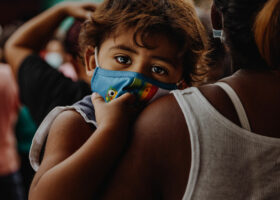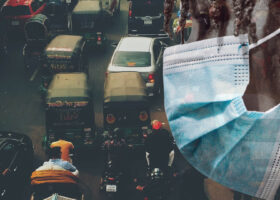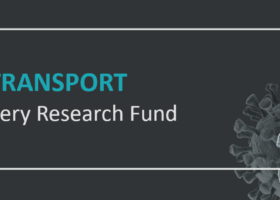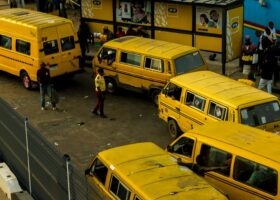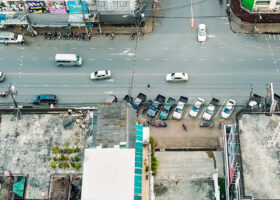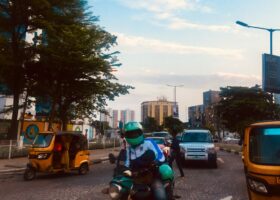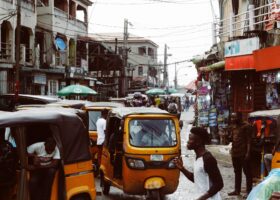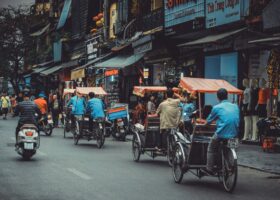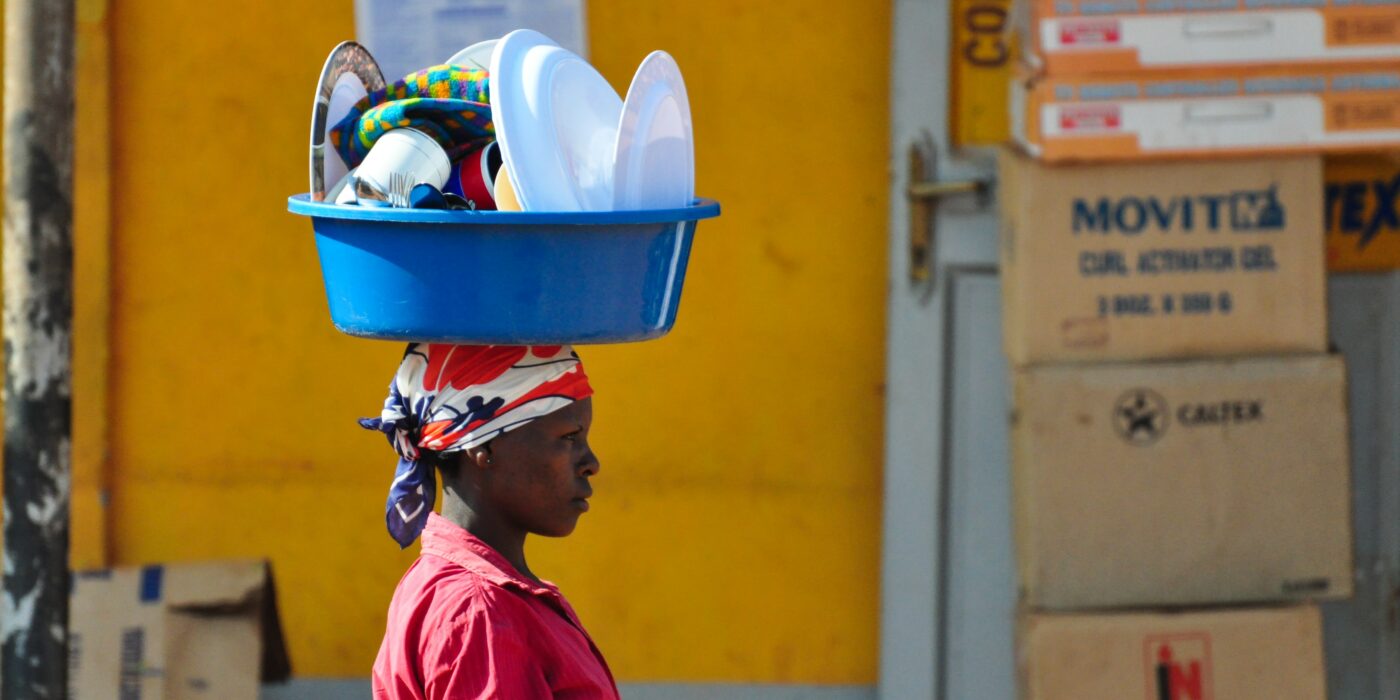
Overview
Disasters and pandemics of all types tend to exacerbate gender inequity and threaten progress for women. COVID-19 emerged into an existing inequitable environment, where women already lived with gender-based transport disadvantage and its implications. This paper draws from and revises a larger research report, ‘Gaining or Losing Ground: ensuring that “post-COVID-19” transportation serves the needs of women with low-income in Sub-Saharan African cities’, a qualitative study in Nigeria, Kenya, Uganda and South Africa. Through a series of in-depth interviews and the lens of the Sustainable Development Goals (SDGs), this paper presents findings that demonstrate the interdependence between the numerous direct and indirect impacts of mobility options and restrictions on women, particularly with regard to access to health-care, education, livelihoods, personal safety, individual agency and independence, and the inequitable financial burden of unpaid work. The study confirms the precariousness of women in SubSaharan Africa, and makes explicit the links between COVID-19 containment impacts, prevailing transport-related disadvantages, and the social exclusion experienced especially by women with low incomes.
Publications with the same themes
Publications with the same study countries
Related news & events
News
Blog
News
News
News
Blog
News
Blog
Blog
PDF content (text-only)
WOMEN WERE PUT ON THE BACK-END: COVID-19 MOBILITY CONSTRAINTS AND THEIR LESSONS AND IMPLICATIONS FOR GENDER-EQUITY IN SUB-SAHARAN AFRICA G JENNINGS1 and E AROGUNDADE2 1 Research Consultant, Email: gail@gailjennings.co.za 2 Research Consultant, Email: emmanence@gmail.com ABSTRACT Disasters and pandemics of all types tend to exacerbate gender inequity and threaten progress for women. COVID-19 emerged into an existing inequitable environment, where women already lived with gender-based transport disadvantage and its implications. This paper draws from and revises a larger research report, ‘Gaining or Losing Ground: ensuring that “post-COVID-19” transportation serves the needs of women with low-income in Sub-Saharan African cities’, a qualitative study in Nigeria, Kenya, Uganda and South Africa. Through a series of in-depth interviews and the lens of the Sustainable Development Goals (SDGs), this paper presents findings that demonstrate the interdependence between the numerous direct and indirect impacts of mobility options and restrictions on women, particularly with regard to access to health-care, education, livelihoods, personal safety, individual agency and independence, and the inequitable financial burden of unpaid work. The study confirms the precariousness of women in SubSaharan Africa, and makes explicit the links between COVID-19 containment impacts, prevailing transport-related disadvantages, and the social exclusion experienced especially by women with low incomes. 1. INTRODUCTION Transport and its infrastructure are not gender neutral. Although the transport arena is highly gendered across the world, it is particularly evident in Sub-Saharan Africa (SSA) where women’s resources (including access to mobility resources) are more constrained due to a ‘mix of entrenched social-cultural… factors’ and male dominance in the transport sector (Uteng & Turner, 2019a; Porter, Abane, & Lucas, 2020). Women in low-income countries have significantly different mobility patterns and needs compared to the ‘male norm’: in addition to having less access to all means of transport, women also assume greater shares of the household travel burden and make more frequent and shorter trips associated with health, food, and caring responsibilities. Low levels of mobility prevent women from making economic contributions at household, regional, and national levels. Women are more at physical risk than are men when travelling and in public spaces; women suffer disproportionally high losses of employment opportunities when relocated or evicted; and cultural limitations placed on mobility influence the way in which women are able to move, for how long they may be away from home, and where they may travel. The cost of transport restricts women further, and affordability limits women’s access to income sources and services (SUTP, 2018; Lucas, 2019; SUM4All, 2019; Uteng & Turner, 2019b, 2019a). __________________________ Virtual Southern African Transport Conference 2021 – 5 to 7 July 2021 The economic and social outcomes of gendered transport disadvantage in Sub-Saharan Africa (SSA) have been ‘glaringly evident’ (Porter, Abane, and Lucas, 2020) for quite some time, which Lucas et al (Lucas, 2019) describe as ‘the systematic process of almost complete ‘lock-out’ from resources, rights, and opportunities’. Even before COVID-19, men were more likely than women to have the final say in household decision-making (UN Women, 2020b) around who travels, how they travel, and for what reason. COVID-19 emerged into this existing inequitable environment, where women already lived with gender-based transport disadvantage and its implications. Given the historic focus on immediate control rather than visionary planning in response to natural disasters (Uteng and Turner, 2019a), COVID-19 constraints were unlikely to exhibit a change in transport thinking. With 2020’s lockdowns, Lucas’ description, above, is prescient. The focus of the research reported here is the way in which existing social exclusion and transport disadvantage were exacerbated by COVID-19 containment processes, and how precarious pre-COVID gains women made in terms of the Sustainable Development Goals (SDGs) have been lost as a result of these processes. SDG 1 (eradication of poverty), SDG 3 (sustainable health systems), SDG 4 (quality education), SDG 5 (gender equality), SDG 8 (decent work and economic growth), and SDG 11 (Inclusive Cities), have particular relevance (UN Women, 2020b). This paper draws from and revises a project report ‘Gaining or Losing Ground: ensuring that “post-COVID-19” transportation serves the needs of women with low-income in SubSaharan African cities’ (see Acknowledgements). The research looks at the unforeseen impacts of the rapid responses due to the pandemic, especially in relation to urban transport, that affected the mobility of urban women with low income. The full report makes suggestions on short- and longer-term interventions to drive equity goals and impacts. 1.1 Scope The study focussed on the experiences and impacts on women in mostly primary cities, considering passenger transport and trip purposes (micro-freight, health-care, food provisions, and livelihoods). The geographic focus of the study was on low-income countries, or women with low-income in middle-income countries, in Sub-Saharan Africa (SSA): Lagos and Abuja (Nigeria); Johannesburg and Cape Town (South Africa); Nairobi and Kisumu (Kenya); and Kampala (Uganda). Many SSA countries restricted movements by public, private, and commercial transport. As part of containment measures for COVID19, travel by public and personal transport was shut down completely for non-essential trips at some point. These restrictions are not detailed in this paper. 1.2 Method This paper is a synthesis and revision of the above-mentioned project report, with an additional analytical lens of the Sustainable Development Goals (SDGs) and UN Women’s assessment of what drives women’s economic empowerment (UN Women, 2017). 1.2.1 Literature Review The full report combined a scan of journal papers as well as policy reports, newspaper articles, and institutional reports and findings. 1.2.2 Conceptual Framework This research is situated within a conceptual framework of transport-disadvantage, and interviews are analysed through an additional lens of the Sustainable Development Goals (SDGs) and the drivers of women’s economic empowerment as identified by UN Women (UN Women, 2017). Researchers have made well-argued links between transport, mobility constraints, and poverty in SSA (Uteng and Turner, 2019a, 2019b). Among the outcomes of these links is a gender-based transport-disadvantage or transport-related social exclusion. Transportdisadvantage is a concept more often underpinned by an understanding of financial poverty (Porter, Abane and Lucas, 2020), but when combined with gender-based mobility constraints, the transport-disadvantage outcomes become more evident. Transport disadvantage has been associated with an inability to access the goods and services necessary to live one’s daily life, and the many consequences include ill-health, maternal mortality, high infant mortality rates; unemployment, poverty or inability to earn a living wage, long and tiring travel patterns, exposure to crime, noise, pollutants; poor education achievement, and inadequate access to healthy, affordable food (Jennings, 2015). Sustainable Development Goal 11 (Inclusive Cities) states that by 2030 all cities should provide access to safe, affordable, accessible and sustainable transport systems for all, improving road safety, notably by expanding public transport, with special attention to the needs of those in vulnerable situations, women, children, persons with disabilities and older persons. In addition, sustainable and safe transport plays a major role in achieving many other SDGs that refer to equity, equality and poverty reduction indirectly (UN Women, 2020b). COVID-19 threatens progress for women and girls in a further five of the SDGs: SDG 1 on eradication of poverty, SDG 3 (health), SDG 4 on quality education, SDG 5 on gender equality, and SDG 8 on decent work and economic growth (UN Women, 2020b). SDG 3 is concerned with access to sustainable health systems, universal health coverage, and a robust health workforce. SDG 5, which addresses gender equality and the empowerment of women and girls, is concerned with the need to break down barriers to gender equality, transforming the underlying norms, structures and practices that prevent women and girls from enjoying their rights (UN Women, 2020b). The UN Panel on Women’s Economic Empowerment’s (UN Women, 2017) has developed seven primary drivers of women’s economic empowerment: strengthening visibility, collective voice, and representation; (ii) improving public sector practices in employment and procurement; (iii) changing business culture and practice; (iv) building assets such as digital, financial, property; (v) recognising, reducing, and redistributing unpaid work and care; (vi) ensuring legal protection and reforming discriminatory laws and regulations; and (vii) tackling adverse norms and promoting positive role models. 1.2.3 In-Depth Key Informant Interviews The literature was complemented by observations and insights provided from keyinformant interviews from the public, private, and civil-society sector. The key informants in each country were selected using both purposive and snowball sampling, for their ability to provide the insights and other information needed, be representative of a wide group of women, and for their knowledge and work within gender, transport, and social development in either the research, practitioner, or advocacy/activist sector. This being qualitative work, there was no expectation of statistical representativity. The number of interviewees (at least four per country) was limited by research budget, research timeframe (one month), and COVID-19 protocols. Interviews were conducted between 26 October and 10 November 2020. One focus group in Cape Town was conducted in mid-November 2020 with women who are foundational to the Cape Town Community Action Network (Cape Town CAN), established as a response to COVID-19 restrictions in March 2020. 1.2.4 Research Questions The review and interviews were guided by the following research questions: • What are the specific aspects of COVID-19 that affect women’s mobility? • What setbacks, brought about by the mobility constraints caused or deepened by the COVID-19 pandemic, have been particular to women? • How have local or national responses in SSA had unforeseen consequences on lowincome women’s mobility (further reducing or improving rebound options)? • Does a renewed reliance on walking (especially due to COVID-19) over motorised modes/public transport perpetuate and/or increase women’s risks of personal safety, reduced opportunities, road safety, and time-poverty? • Have the needs of women been included in the responses by authorities? • Have the direct or indirect impacts of transport measures pre- and post-COVID-19 furthered or reduced any progress in female equality, equity and empowerment? 1.2.5 Analysis Interviewee’s responses were captured and tabulated according to the questions above. A list of initial themes based on research questions and researcher observations formed the basis for initial engagement with, and organisation of the data. These initial themes were expanded to include themes emerging from interviewees, and in a second round of analysis and writing, the relationships between themes demanded some merges, and some re-organisation. The final themes include the economic impact; transport availability and cost; essential workers and transport vulnerability; domestic responsibility; women who work in transport; loss of agency; personal security, harassment and violence; access to physical and mental healthcare; education; walking; cycling; and participation in decision making. Each theme is discussed in terms of its intersection with transport, access, and mobility, and recommendations were drawn from these interview findings. In this paper, the focus is broadly on the economic impact and quality of life impact which emerge from the analysis in the report. 2. FINDINGS 2.1 Economic Impact Our interviewees described a range of ways in which economic impacts were experienced by women with (already) low income, and those who fell in low income during this time. 2.1.1 Informal Trade For many women who were involved in small businesses selling goods, transport restrictions had negative impacts. In Nigeria, AX raised the issue that women were more likely to sell perishable goods, and in Kenya, HK painted a comprehensive picture of the experiences of women traders: ‘Women who are mostly petty traders in informal settlements, who trade in agricultural products, clothes, food, were dramatically more affected. They usually have to travel to collect their goods to sell, as they source their goods elsewhere, then bring them back to their structures...The capacity limits had a particular impact – for example, they would usually take a tuk-tuk, which would carry five people; but now that it can only carry three, they have to make up the fare. In this way, the cost of travel went up. Likewise, if you travel in a matatu, not only does your own fare go up, but so does the fare of your goods...’ NM (South Africa) and FA (Nigeria) also noted that many women food sellers’ customers no longer travelled to or from work, so those who relied on supplying commuters at taxi ranks, or regular passers-by, were not able to earn. 2.1.2 Domestic Work Domestic work is a sector dominated by women with low income. This sector saw many job losses, especially in Kenya and South Africa according to our interviewees. This was partly because domestic workers rely primarily on public transport, which some employers saw as a COVID-19 infection vector. Thus domestic workers became ‘undesirable’ even once they were permitted to return to work (LS, South Africa). 2.1.3 Transport Costs We asked interviewees to talk about the transport restrictions and changes, and how these impacted generally on the lives of women who have low incomes, as well as their personal experiences. There was no direct exclusion of women in terms of denying them access to the transport available, and usually restrictions were circumstantial. Fare increases, fewer options, and long waits were consistently mentioned. NK (Uganda) provides a good example of this: ‘It became more usual to have to wait two hours at a stage waiting for the taxi, which was twice the price when it came, so many women just stayed at or near home.’ As the transport used by women with low income is predominately private-sector paratransit (matatus, minibus-taxis, danfo), they were significantly impacted by the fare increases, lower capacity (resulting in longer waiting times) and a greater fear about contracting the virus by using public transport. These services are largely unsubsidised or uncontrolled by government; therefore, government has little capacity to ensure that fares do not increase. These increases were considered to have had the most significant impact on mobility. Restrictions on capacity and physical distancing requirements led to paratransit operators requiring children to be paid for separately, where women used to be able to carry children on their laps (AK, Kenya; FA, Nigeria). FA (Nigeria) also mentioned that if women tried to negotiate lower fares for their children, they may get left behind. Not only did children cost extra, but women were more likely to be travelling with children, as schools were closed and women were reluctant to leave their children at home with older siblings alone, or with a neighbour. 2.1.4 Hidden Costs: Time Poverty and Violence The times at which public transport was available during COVID-19 were designed for commuters and essential workers. These times were a challenge for women who were used to making more frequent and shorter trips associated with their caring responsibilities. As NM (Kenya) describes it: ‘women's travel patterns and needs are still very different from that of men and hence restrictions like curfew do not consider that women's travel needs are centred on care responsibilities.’ Again, HK (Kenya), painted a vivid picture of the need for off-peak services even during lockdowns: ‘I leave in the morning early, and you’ll find more taxis, more people travelling. But picture this lady who has her children back home, they are not in school. When they are in school, she would prepare them and they would leave together. But now the children are home, she can’t leave as early as they would have. Now, she has to prepare these children, and the meals before, and clean the house, and by the time she has done all these things, your mode of transport has by now reduced. The readily available ones are boda boda, with the safety and other concerns. And then again, she has to quickly make sure that she comes back home in good time to prepare the children again…’ Many women described walking being a sometimes necessary part of travel due to routes being shut down, according to NM (South Africa), but also as an alternative to public transport – if women left the home at all. ‘In many instances, women simply didn’t move from home, and chose to reduce mobility rather than walk’ (AK, Kenya). Walking as a mode of transport has its limitations in distance and time (this is especially difficult for women who are already time poor, and frequently need to travel with small children). In addition, they usually walk for a purpose – mainly shopping – and then the children need to be carried back home. The threat of crime (SS1, Nigeria), sexual violence (EO, LGG, Nigeria, GO, South Africa), and in South Africa a rise in rates of kidnapping (RD, South Africa), were also raised as reasons women would not want to walk. In addition, a number of references were made to the lack of safe walking areas on the road; women in particular were not happy to walk in the dark as the infrastructure is poor and lighting bad. ‘You can fall down a pothole or into a storm drain if you are not careful.’ In Uganda, AN pointed out the shortcoming of urban planning with so many people living so far from their places of work. Relying on walking only limits ‘what you can and cannot access’ as a result. As EO (Nigeria) phrased it: ‘Many women just stopped travelling beyond where they could walk.’ One implication for women was that they needed to rely on the more expensive local suppliers for food, as finding bargains involved trips on public transport. And as noted above, for many women, providing food is their responsibility. In order to decrease these costs, AWA and FN (Uganda) would walk to the local market, and then find a trustworthy boda-boda driver to carry goods home while they walked back. AWA said the drivers were keen to make money this way as they had fewer passengers. In addition, FN (Uganda) added that the curfew for ‘vehicles starts at 9pm but boda bodas [could] only drive until 7 pm. This means that women have been told to get off and walk if the driver does not think he will get back to his house in time for the curfew.’ Walking as a primary mobility measure also had an impact on time poverty: ‘I think it’s time, three hours because of travelling time impacts on other responsibility’ (EA, Nigeria). NM echoed the issue of time poverty, and raised the additional aspect that in Kenya, women had to do careful planning around when they could be out walking because of the threat of police brutality after curfew. 2.1.5 Impact on Women Working In Kenya there were multiple job losses for women working in the matatu (paratransit) industry. Women were mostly conductors, and these were the first people to be let go as operators ‘rationalised’ in response to lower overall incomes (AK, Kenya). According to NM (Kenya), women who did retain their jobs feared either ‘catching’ COVID-19 or spreading it to their families, as they were in close contact with many people every day, handling cash. During periods of complete lockdown, essential workers across all countries were still required to work, often with little attention given to transport requirements, or the increased domestic requirements at home. SS1 (Nigeria) mentioned the difficulties for healthcare workers specifically: ‘No special transport for health workers [was available], which meant that if they were working shifts it was really difficult for them to get to work and also with less services they often had to walk more so they got to work tired.’ In Uganda, market vendors were required to sleep at their market stalls. Obviously, the impact for women who had families to care for was immense. 2.1.6 Household Impact Women experienced increased pressure in terms of domestic responsibilities in the face of lowered income, closure of schools, and not being able to rely on extended networks for help with care and support. What is not often evident in the literature is the impact of limited mobility on having to fulfil these traditional roles. As CO (Kenya) said, ‘at home, men still expected them to provide these services [of providing food] but movements were restricted. So they had to go to places closer to their homes, which sometimes were more expensive.’ Family food supply was a preoccupation in many of our interviews. In Nigeria, market opening times were reduced and mobile markets were temporarily banned: ‘Many markets closed and also as women could not get to the market early (either they had to walk or try to get on a minibus taxi when they were running) it meant that all the “good stuff” had gone or maybe what they wanted /needed to buy was sold out’ (EO, Nigeria). SS1 (Nigeria) concurred: ‘Food was also sometimes in short supply and it was more expensive so women who had no income (daily) really found it difficult to feed the family as this is still women's work in our culture.’ As women were often unable to rely on their usual networks of support, they would have to take their children with them if they went anywhere: ‘It's hard to be in a society where you already feel like you can't move around, and then it's more enforced on you by these small things. You can't easily change, you can't send your child to the next house, you can't take them with you either as there is the cost of carrying an extra body…’ (NM, South Africa). Reduced income also meant making difficult choices across apportioning money to food, transport, school fees and dealing with increased domestic expenses, with additional costs relating to COVID-19 prevention, such as water, sanitisers, and masks. One person indicated that with the cost of transport, not as many children will be able to return to school after restrictions ease: ‘Younger girls may not be able to go back to school now as the cost of transport is too high for families to send the same number of children to school as before – and so the girls stay home as they can be useful to the mothers while the boys are not’ (FA, Nigeria). 2.2 Impact of Mobility Changes on Women’s Quality of Life 2.2.1 Loss of Agency Not always explicit, but a theme throughout the interviews were the constraints placed on women in relation to their agency. Already constrained in many cases by cultural expectations about their roles and responsibilities, exacerbated by lockdown and lack of access, or means to access transport, women’s agency was dramatically reduced. SS and LGG (Nigeria) both noted that with less money, women have less say compared to men in their families. Some more explicit examples were offered in the South African context. RD, as a regular public transport user, said transport restrictions ‘impacted much, cause I could just get in a taxi and go, and now I can't, because why, only a certain amount of people is allowed to be in a taxi, and it can only go to a certain place, and either they get pulled over by traffic cops or law enforcement so. I can't just make boss moves.’ PS (focus group, South Africa) added: ‘I think the lockdown changed everyone, it took your freedom away, it took your choices away. Everything was taken away. It showed us a different type of world where we’re not in charge.’ ‘It goes across the board,’ said NM (South Africa). ‘Whether you have your own vehicle or predominantly have to rely on public transport, women were put on the back end when it was time to decide who moves around outside the house. Home care fell on women, and you had that loss of agency was because of your family structure. ... When decisions have to be made, that is how the patriarchy works...’ 2.2.2 Levels of Domestic Violence Related to loss of agency, violence or the threat of violence is often an implicit constraint for women’s sense of agency, and mobility (as noted above in relation to walking). Multiple mentions of the increased rates of gender-based violence were raised by our interviewees (especially LGG, FN, UR, Nigeria and Uganda). Uganda Country Director of CARE International, Apollo Gabazira, described how the power dynamics of increased poverty place women and girls in a position of subservience, which means they suffer the most in times of crisis (Habib, 2020). The impact on trade and travel meant that women were unable to maintain financial independence, which exposed them to further abuse: ‘women [were] at the abusive partner’s mercy’ (JohnBosco & Ggoobi, 2020). Media reported, too, that ‘a transport ban in Uganda means women are trapped at home with their abusers.’ (Donovan, 2020). Increased domestic violence/gender-based violence was widely considered to have increased dramatically (see Haffajee, 2020). What is often not taken into account is how the women experiencing physical and emotional violations were constrained from seeking help due to transport limitations. Many were unable to go out of the home especially due to curfews, nor could they call hot lines or call centres. Rape Crisis Cape Town Trust (South Africa) saw a dramatic uptake of their WhatsApp counselling service, as clients often could not find a private place to talk; Rape Crisis carried the burden of costs for calls and data. The inability of clients to come and speak to counsellors face to face had a detrimental impact on their recovery. In addition, although movement was allowed for sexual violence survivors to access relevant police and health services during the hard lockdown, not everyone was aware of this. 2.2.3 Access to Physical and Mental Healthcare Women making difficult choices with limited resources in conjunction with rising transport costs and restrictions led some women to neglect taking their children to access required healthcare. For example, LGG (Nigeria) said: ‘Mothers did not take children to the clinics and had no money for medicine if you needed it.’ This was also true for immunisations, which may have a longer-term impact for disease prevention and the healthy development of young children. Transport restrictions with long waits also meant leaving home to get medicines, especially if there were people at home to care for was difficult: ‘Anything, I mean even when you want to get medicine or what, there's no transport. You can't go out to get food, you can't go out to get medication, you can't go out even if you look after a child in the house...So that's difficult because she has to wait for the taxi to come because there's only a certain amount of taxis that could be on the road, and so she can't walk the distance and things like that, so when it comes to females, it's more like being able to provide for their homes, like be it for food, or for medication, the basics.’ (RD, South Africa) Specific challenges around pregnant women reflected issues raised in the literature. For example, HK (Kenya) relays this information: ‘There were a number of instances where maternal health was a challenge, when women started labour after curfew time. What happened is that government came down so hard, at 7pm we had the police out there, beating us. There was so much fear. And if you call your boda boda guy, he says “no, I can't go out”. But eventually these issues were addressed formally, and the pregnant and sick were allowed to get a permit to go out after curfew. But when it started it was not good – the police were not interested in hearing from you, and women were more at risk.’ In Kenya, for example, the negative impact on pregnant women seeking healthcare during curfew times was taken up by various organisations, which forced concessions from the government as well as private taxi drivers themselves (AK, NM, Kenya). The National Union of Women with Disabilities of Uganda noted that the response to COVID-19 was not ‘inclusive’, and ‘has exacerbated the challenges faced by persons with disabilities and especially women with respect to those in need of medical assistance, and with health centres distant from resident areas (International Disability Alliance, 2020). The deaths of pregnant women were reported, as well as the deaths of children who had to be transported by foot to health-care facilities, due to restricted motorised transport. (Hayden, 2020). Although people were permitted to travel with approval from resident district commissioners for medical emergencies, this approval was not easy to obtain – in part, precisely because of travel restrictions. 3. CONCLUSION Typical COVID-19 responses have had an evident gendered impact, linked to the countries’ transport restrictions and limitations. Women’s needs and rights had been largely overlooked in transport planning and investments even before the pandemic (SUM4All, 2019). It is clear that the immediate effects of COVID-19 have deepened and widened the existing fault lines of transport, economic, and social inequity, entrenching transport-disadvantage and social exclusion and their multiple impacts among women (UN Women, 2020a, 2020b). An overarching response from interviewees was that, in their view and experience, women had been particularly disadvantaged during 2020 as a direct result of COVID-19 restrictions. Both economic and social impacts were consistently mentioned, including that women were more likely to have lost their jobs and livelihoods (compared to men in similar circumstances), and this was further compounded by increased levels of care and family duties (and the increase in domestic violence). This combination suggests that many women will struggle to return to previous – already disadvantaged – levels of financial and societal independence within the foreseeable future. Through the lens of the UN Panel on Women’s Economic Empowerment’s (UN Women, 2017), it is evident that COVID-19 related mobility constraints affected almost every one of their identified drivers of economic empowerment: weakening women’s contribution to the economy, entrenching adverse norms, increasing unpaid work and care, limiting women’s ability to build assets, and exposing implicit discriminatory practices in employment and fare structures, among others. As UN Women describes it, during a health emergency, the ‘tyranny of the urgent’ often takes over (UN Women, 2020b), and resources are directed toward the response. The downstream effect, in the instance of COVID-19 mobility restrictions, has been that women have been set back particularly with regard to access to health-care, education, livelihoods, personal safety, individual agency and independence, the ability to safeguard assets, and the inequitable financial burden of unpaid work. The findings from this study also demonstrate the ways in which previous pre-COVID-19 gains for women in achieving relevant SDG’s have been lost. The study confirms the precariousness of women in SubSaharan Africa, and makes explicit the links between COVID-19 containment impacts and prevailing transport-related disadvantages and social exclusion experienced by especially women with low incomes. The full report reflected on this interdependence between the numerous direct and indirect impacts of mobility options and restrictions on women, and made several evidence-based recommendations that cover specific aspects of women and transport, such as short-term interventions regarding access to markets, food, water, and healthcare. Ensuring that girls are able to return to schools and colleges is essential; and immediately providing affordable (or free), safe and convenient public and scholar transport is key. Longer term efforts must centre women’s unique transport needs in the thinking, planning and operationalising transport systems in these cities, including increased numbers of women in decision-making, with insight into gender-responsive approaches. If transport decisionmakers ‘paid attention to the type of input we are already giving,’ says AWA (Uganda), ‘providing a social lens into infrastructure and facilities development, then women’s needs would begin to be met.’ 4. ACKNOWLEDGEMENTS This paper revises work published in a project report titled ‘Gaining or Losing Ground: ensuring that ‘post-Covid-19’ transportation serves the needs of women with low-income in Sub-Saharan African cities’. Interviews were undertaken by Emma Arogundade, Gail Jennings, and Heather Allen. Heather Allen and Jeff Turner contributed to the development of the interview questionnaire and also reviewed the project report. The research was funded by UKAID through the UK Foreign, Commonwealth & Development Office under the High Volume Transport Applied Research Programme, managed by IMC Worldwide, as part of the COVID-19 Research & Response Transport Recovery Fund. We gratefully acknowledge the input of our interviewees, who provided valuable insights and perspectives. The full report is available at this link: https://transport-links.com/download/gaining-orlosingground-ensuring-that-post-covid-19-transportation-serves-the-needs-of-women-in-lowincome-sub-saharan-african-cities/ 5. REFERENCES Donovan, L, 2020. A transport ban in Uganda means women are trapped at home with their abusers - CNN. Available at: https://edition.cnn.com/2020/05/15/africa/ugandadomestic-violence-as-equals-intl/index.html. Accessed 23 October 2020. Durizzo, K et al., 2021. ‘Managing the COVID-19 pandemic in poor urban neighborhoods: The case of Accra and Johannesburg’, World Development, 137, p. 105175. doi: 10.1016/j.worlddev.2020.105175. Habib, J, 2020. How the Coronavirus is Impacting Women, Girls and Refugees in Uganda, CARE. Available at: https://care.org/news-and-stories/news/how-the-coronavirus-isimpacting-women-girls-and-refugees-in-uganda/. Accessed 23 October 2020. Haffajee, F, 2020. Covid-19’s Impact: The day the bottom fell out of South Africa – a triple pandemic has hit us, Daily Maverick. Available at: https://www.dailymaverick.co.za/article/2020-07-15-the-day-the-bottom-fell-out-of-southafrica-a-triple-pandemic-has-hit-us/. Accessed 23 October 2020. Hayden, S, 2020. Children, women casualties of Uganda’s coronavirus transport ban, Al Jazeera. Available at: https://www.aljazeera.com/features/2020/04/21/children-womencasualties-of-ugandas-coronavirus-transport-ban/. Accessed 23 October 2020. International Disability Alliance, 2020. Voices of some under-represented groups from Uganda, International Disability Alliance. Available at: https://www.internationaldisabilityalliance.org/blog/voices-some-under-representedgroups-uganda. Accessed 23 October 2020. Jennings, G, 2015. ‘Public Transport Interventions and Transport Justice in South Africa: A Literature and Policy Review’, p. 12. JohnBosco, L & Ggoobi, NS, 2020. Covid-19 and the rising levels of domestic violence in Uganda. Policy Brief. Gateway Research Centre. Lucas, K, 2019. ‘Transport and social exclusion in Five African cities’. Intalinc, VREF. Porter, G, Abane, A & Lucas, K, 2020. ‘User diversity and mobility practices in SubSaharan African cities: understanding the needs of vulnerable populations.’ VREF. SUM4All, 2019. ‘Global Roadmap of Action Toward Sustainable Mobility: Gender.’ Sustainable Mobility for All. Available at: http://pubdocs.worldbank.org/en/229591571411011551/Gender-Global-Roadmap-ofAction.pdf. Accessed 12 November 2020. SUTP 2018 ‘Approaches for Gender Responsive Urban Mobility’. GIZ-STUP (Sustainable Urban Transport Project). Available at: https://www.sutp.org/publications/approaches-forgender-responsive-urban-mobility-gender-and-urban-transport-smart-and-affordable/. Accessed 12 November 2020. UN Women, 2017 Seven economic empowerment drivers and recommendations, UN Women. Available at: https://hlp-wee.unwomen.org/en/about/seven-drivers. Accessed 28 March 2021. UN Women, 2020a COVID-19 and its economic toll on women: The story behind the numbers, UN Women. Available at: https://www.unwomen.org/en/news/stories/2020/9/feature-covid-19-economic-impacts-onwomen. Accessed 12 November 2020. UN Women, 2020b Will the Pandemic Derail Hard-won Progress on Gender Equality? Spotlight on Gender, COVID-19 and the SDGs. Spotlight on the SDGs 4. doi: 10.18356/ee038877-en. Uteng, TP & Turner, J, 2019a. ‘Addressing the linkages between gender and transport in low- and middle-income countries’, Sustainability. Uteng, TP & Turner, J, 2019b. ‘State of the Knowledge Study on Gender and Transport in Developing Economies’. UKAID, High-Volume Transport Applied Research Programme.



